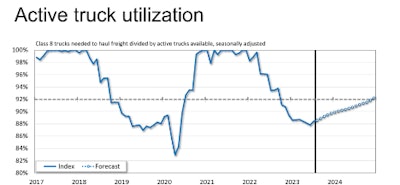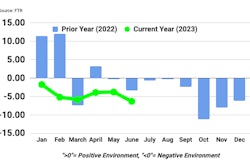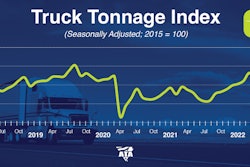
FTR's trucking and rail analysts see a soft future, even as 2023 hits peak freight season.
"The peak season is not going to be robust for carriers, even if we do see more strength than we've seen up to this point," says Vice President of Trucking Avery Vise. "We're not expecting a whole lot of [freight] rate strength in the next six months or more."
[RELATED: FTR's Jonathan Starks shares his forecast for the 2024 trucking economy]
Vise laid out a general economic scene that is less than inspiring. Consumers are still spending despite a softening in economic conditions, he says, even as student loan payments resume for many Americans this month. Mortgage rates are also at their highest point since 2002 and inflation remains above the Fed's target rate.
Personal savings is low, but stimulus-buoyed cash reserves are still high, though off its peak levels. Household debt and credit card delinquency rates are starting to inch up, and student loan payments will definitely have an impact on that, Vise says.
"The bottom line is you would expect one of two effects," Vise says, outlining a scenario where people spend less on goods and services to pay the student loans or that people spend the same, just incur more debt.
[RELATED: The state of the U.S. economy, and what is likely for 2024]
No matter what, all of the buying isn't likely to continue.
"Clearly, [spending] cannot continue," Vise says.
Meanwhile, conditions will continue to favor trucking over rail and intermodal, Vice President of Rail and Intermodal Todd Tranausky says, even though the industry as a whole continues to do well.
"We're still negative relative to truck," Tranausky says, and FTR doesn't see 2024 changing a whole lot. "We're essentially in neutral at this modestly negative level."
Tranausky chalked the negativity up to several factors, including a shift in imports from the West Coast to the East and Gulf coasts. Those ports, with generally shorter hauls to goods' final destinations, tend to favor trucking over intermodal, Tranausky says.
Most of the West Coast loss has come from California, and while it's possible that a resolution of labor issues in the state can bring some volume back, the market doesn't expect much, Tranausky says, as shippers have developed relationships in the new ports and like their options there.
Still, Vise says trucking remains a bit soft in the dry van market, running below the five-year average in loads and rates. Reefers are yet more weak, but still in line with expectations, FTR says.
[RELATED: FTR: Trucking Conditions Index shows weakness for carriers]
Trucking employment remains historically high, Vise says, with a spike in CDL driver hiring activity stemming from other carriers snapping up former Yellow drivers.
"A lot of carriers went shopping," Vise says, looking to upgrade their driver force. "We've never had such a supply-driven phenomenon."
Smaller carriers are continuing to throw in the towel, coming off record numbers fueled by pandemic issues. Vise says depressed spot rates and high fuel costs will continue to see these carriers exiting the market.
"A lot of these drivers would be financially better off if they could get jobs as company drivers," Vise says.









